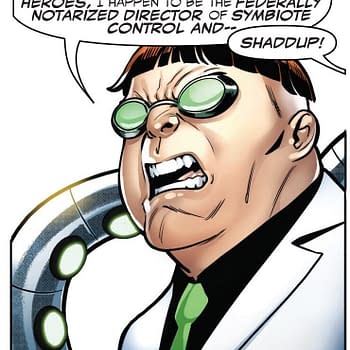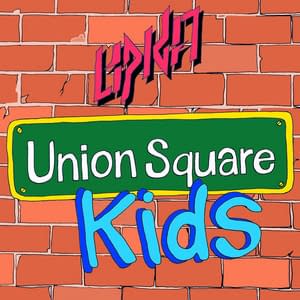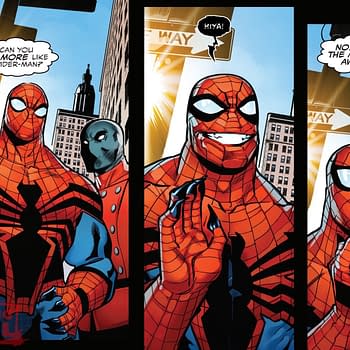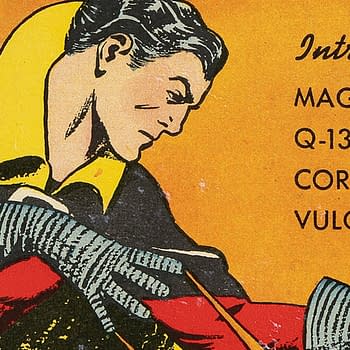Posted in: Comics | Tagged: Comics, dirk manning
How To Make One Million Dollars in Comics (Part 2 of 2) – Write Or Wrong #77 By Dirk Manning
If you haven't yet read the first part of this two-part column, somehow missed it, or simply want to review it, click here to check it out, as it's where I do some breakdowns concerning the costs of Print-On-Demand vs Off-Set Printing in regard to printing your own comics – which is exactly what you'll have to do to see your work in print unless/until you get your book picked up by a publisher of creator-owned comics such as Image, Dark Horse, etc.
Because make no mistake, aside from "The Rub" that comes with being associated with a major publisher (more on that next column), the other two biggest perks are access to lower printing costs and easier distribution through Diamond.
Most early/aspiring creators aren't yet associated with a major publisher, though, and that's where the challenge lies, in regard to making money, for a lot of creators.
(That's not to say that being affiliated with a major publisher – even one as red hot as Image Comics is right now – will automatically mean that you'll start making money in comics, mind you… but that's another whole topic in and of itself.)
Regardless of what path you choose to take when it comes to making money – and hopefully/ultimately a million dollars over the course of a lifetime – in comics, one universal truth, first taught to me by Grandpa, remains:
You'll have to spend money to make money.
I know some of you out there right now are having that knee-jerk reaction of "But Dirk, I don't have much money to spend!" and so I will now again remind you of Grandpa's sage wisdom in regard to starting small:
"If you only have $20, buy twenty hats for one dollar each. Sell each hat for two dollars each, and now you have $40. Now go buy forty hats for a dollar each, and sell each one for two dollars each. Now you have $80…"
Those of you who've been reading this column for years now (or have bought the first book collection Write or Wrong: A Writer's Guide to Creating Comics which is available in print or digitally from Amazon right here) are probably tired of hearing me say this, but making comics – and making money in comics – is a marathon, not a sprint.
To that end, if you really want to "make a go" at being a professional comic book creator who is not only making comics but active – on at least a regional/mid-sized scale – I would recommend doing what you need to do to have about $2,500 a year ready to devote to the cause.
That's about $208 dollars a month, which, admittedly, is not chump-change. However, the upside is that you don't need it per month but rather that total amount annually if you want to really make a run at things.
Some of you out there may be able to get the bulk of this money from your yearly tax returns, while others of you may have to pick up extra hours at work or a second part-time job. For whatever it's worth, I've used both of these avenues for years.
Furthermore, though, here's another piece of advice from me to you: If you're serious about making comics, printing physical copies of them, and then hitting a couple conventions a year (or so) to sell your books and build brand awareness, take a good hard look about how much "stuff" you have and how much money you spend on stuff you don't need per month, and instead reallocate that money to your "professional comic book fund."
Excessive/unnecessary purchases may include, but are not limited to, fast food/going out to eat on a regular basis, comics that don't genuinely and utterly excite you to the point where you will re-read them often, buying DVDs and Blu-Rays that you could just as easily rent from Netflix or Redbox, new video games (do you really have to be one of the first million people to play it?), going to see movies in the movie theaters (especially at non-matinee prices) action figures, booze, clubbing and/or extraneous out-of-town vacations.
Sure, sure, you should be able to spend some money on yourself for fun here and there… but keep in mind – especially if you're on a limited budget – that money you spend on frivolous things is money you're taking from your goal of becoming a professional comic book creator and ultimately starting to make money in comics.
I realize this may be a bitter pill to swallow for some of you, but it really comes down to a matter of (as I discuss in Chapter Five of that Write or Wrong book I keep mentioning) how badly you want to make it happen.
I wanted it badly enough that I quit "going out," quit buying so much extraneous stuff, nixed all my vacations and picked up a second job (not including my full-time job, my martial arts teaching/training, and/or my actual comic writing) for five years to ensure I had the money available to maintain/secure the funds necessary to invest in my future.
Maybe you'll have to do all of that, maybe you won't. I don't know exactly how your mileage may vary… regardless, the main thing to keep in mind is it takes money to make money.
That being said, let's say that you are to a point where you have $2,500 to invest in your comic career over the next fiscal/convention year (however you define it), and you've banked up this money by not going out to eat anymore, working extra hours at work, and not buying so many of those comics that you're only going to read once and then bag-and-board and file away.
As discussed in the last column, you've done the POD thing for a year or three, printing very small runs of your black and white comics and selling them at local conventions, usually taking a small financial loss in the process, but feeling OK about it since you've been building your brand quite nicely.
Now, you're ready to take the plunge into doing several regional shows. Now you're going to go through a POD or an off-set printer that can offer you 1,000 copies of your first comic "real" comic: a 28-page full color adventure eloquently titled Your Comic #1 for the unit cost of $1 an issue.
(As discussed in the last column, you could print 500 copies of your full-color 24-page comic for around $840 plus shipping… but considering that you can double your amount of books – hence having plenty to give away, send to editors and reviewers, etc. – for a mere $160, we're going to go that route for the sake of this discussion. Keep in mind, though, that 1,000 comics is the equivalent of seven short boxes of the same issue of the same comic. That's a lot of copies of the same book, my friends. We'll revisit the potential perk of ordering 500 copies of each book as opposed to 1,000 in a little bit, though, so don't give it a second thought for now.)
We'll say you have the space to store all 1,000 copies, so you're going to "go big or go home," and make the $1,000 investment, leaving you $1,500 to spend on non-printing costs for the year.
You decide to take that money and invest $1,000 of it in four to five smaller/regional shows where you can get tables for $200 per con by either yourself or by sharing it half-and-half with someone else.
Going this route will leave you $500 for travel, food, and hotel expenses. If you're willing to split hotel/driving costs with friends; or couch-surf whenever possible; live off granola bars, water and peanut butter sandwiches during convention weekends; and can stop yourself from raiding the "50% TPB" bins at the conventions… well, it will be tight, but you should be able to make that budget work.
So, all of that that being said, you've spent $2,500 to print 1,000 copies of your comic and set up at five shows over the course of a year.
How are you going to make up that money? Let alone come out ahead?
Let's find out, shall we?
Let's say, because you're awesome, you sell an average of 50 comics a convention. That's a pretty high number, but, hey, you've been reading this column far, so let's be optimistic, eh?
Based on the numbers above, selling 250 copies of your comic over the course of a year will yield you a profit of $982… which won't even cover your printing costs, let alone the $2,500 you've invested into this year of being a professional comic book creator.
Damn.
Luckily for you, you're tenacious, though, and as such you've set up a signing at your local comic shop (and contacted the local newspaper to get some coverage for it there – thus increasing your exposure). You've also set up a workshop on making comics at your local library (because, you know, you're a professional comic book creator, now) and even set up at your local comic shop for Free Comic Book Day (where you will actually manage to sell some books to adults while also giving some away to the kids – after all, you have 750 copies of the thing lying around, you know?). Throughout all of these efforts, you manage to sell another 100 comics, making your grand total profit for the fiscal year $1,375.
For those of you who don't like doing math, that means you're approximately still $1,125 dollars in the hole.
Damn.
Remember where I said that it takes money to make money, my friends? Here's where we're going to put your determination to the test.
The following year – or, more specifically, the next convention cycle – you're ready to release Your Comic #2.
In the past year you've been releasing Your Comic #1 online, building both brand awareness of yourself and your comic. You even got your comic accepted through the Comixology "Submit" imitative, and made a few sales that way.
You've also saved up another $2,500 via tax returns, working that second job, and cutting back on buying comics or other things you don't care about that much to begin with.
(You of course still buy mine, though, because we're friends, and friends help support each other.)
Nervously, you invest your hard-earned $2,500 into printing 1,000 copies of Your Comic #2 and setting yourself up for the same convention circuit that you just did last year, splitting tables with the same folks, couch-surfing with the same bemused family members and friends, etc.
You then hit the convention circuit, now having a grand total of $3,625 wrapped up in your comic career as you begin your second year as a professional comic creator.
Because people are getting used to you, and you're getting better at selling comics at conventions, and because you now have TWO issues of Your Comic on the table, at the end of your five conventions over the course of a year you sell about 100 comics per convention, resulting in a total of 500 comics sales throughout the course of the five conventions.
(For those of you wondering, it's 250 copies of Your Comic #1 and 250 copies of Your Comic #2, respectively. Again, these are optimistic numbers… but we'll go with 'em just because, hey, I believe in you and, while difficult, it IS remotely possible if you and your work connects well and resonates with readers.)
By also doing another "book release party" at your local comic shop and then returning there for Free Comic Book Day; setting up another workshop at the library; continuing to (responsibly) promote yourself and your work online, adding a workshop at the local art fair to your schedule (something you didn't do last year), and getting your new comic onto Comixology alongside your first one, throughout the year you sell another 200 books on top of your convention sales, bringing your grand total of books sold to 700 and your total profit for the year to $2,751.
Considering that you started the year with $3,625 invested in your comic career and brought in $2,751 in profit, well, that means that you're now only "down" $874 when all is said and done.
That's pretty good, considering how a year ago you were $1,125 "in the red." Through your hard work in comics, you've brought down your debt by $251, released a second copy of your book, and successfully attended another five conventions.
All things considered, having all this cost you only $874 total in two years really is a huge reason to celebrate.
By this point you probably haven't had a nice meal at a restaurant in quite some time. Treat yourself to a steak or something. You've earned it.
Now that you've eaten a nice meal and feel better, let's extend this scenario out one more year, because it's "Year Three" that's a "make it or break it" year for even the most dedicated up-and-coming comic creators.
Nervously, again, you again invest $2,500 into printing Your Comic #3 and doing the same five conventions you're done for the two years prior, now making your investment in your comic book career a grand total of $3,374.
At this point your bottom lip trembles uncontrollably every time you write a check to the printer or a convention organizer. Your family thinks you're crazy. You routinely dream about writing comics. You don't remember the last time you were able to even so much as take a walk around the block without feeling like you should be spending the time writing or promoting your work online somewhere.
Keep in mind, though, that you have three issues of your comic out, a strong online and convention presence in your area, and – gosh darn it – you're living the dream, my friend.
Many people you know have spent at least that same amount of money over the last three years on vacations and Blu-Rays and going to the bars… but you're spending that money making comics… and now you're starting to really see the benefits of it.
Over the course of your five convention appearances in Year Three – combined with some local comic shop, art fair, library appearances and the like (to say nothing of your few digital sales through Comixology that you've gotten by getting some good reviews and podcast interview plugs in here and there), you've sold a total of 750 copies of your combined three issues of Your Comic in the past year.
That's a lot, but you've been busting your butt to make it happen… so, again, take a bow, as you've earned it.
When all is said and done, selling 750 copies of your comic has yielded you $2,974.50 in profit from your comic sales alone. Considering that you had $3,374 invested in your professional comic book career at the beginning of the year, you're now only down to being $399.50 "in the red" at the end of the year… based on sales of your creator-owned comic alone.
At the end of year one you owed yourself $1,125.
At the end of year two you owed yourself $874.
Now, at the end of year three, you only owe yourself about $400.
It may not seem like it looking at the numbers, but you really are making a lot of progress.
All of that being said, now consider this: Had you kept on the same exact budget but only printed 500 books each year (even using the "generous" numbers I did above, in three years you most likely won't sell all 500 copies of any of the three issues – no, not even Your Comic #1), you would have saved yourself $450 over these past three years, resulting in a $50 profit by the end of Year Three!
Granted, neither of these scenarios take into account the costs you will most likely incur in paying the artists you'll be working with to produce the comic pages that make up the books (meaning, realistically, that you may "owe yourself" even a little more money than what we've discussed)… but the point is, each year you're bringing in more money while "investing" less and less.
Furthermore, the other factor this equation doesn't figure into the equation is something I call "The Snowball Effect."
For example, if you're out there on the convention circuit year after year, bringing a new comic with you each time (whether it be new issues of the Your Comic series or a brand new one-shot title each year), people are most likely going to notice…
And when people start noticing that you are putting out good comics year after year, they're going to want to work with you.
This could mean editors at small publishers may offer you some work-for-hire writing gigs…
Or it could mean that perhaps a small publisher will be willing to start publishing your work as part of their brand, giving you access to even cheaper printing costs…
Or it could mean that you'll be able to start picking up some paying work editing other writers' scripts…
Or it could mean that you'll start selling lots of copies of your comic through digital venues such as Comixology or even IndyPlanet, which, as far as you're concerned, is really free money…
Or it could even mean that you are now to the point where you're enough of a "known entity" that you will be able to fund the printing of next year's Your Comic #4 through a crowd sourcing avenue such as Kickstarter.
These are just a few of the many ways that you could not only start bringing in more money via in your career through comics and potentially start to (more quickly) make a profit.
Let's dream bigger, though, and go even one step further.
Let's say that you do, indeed, get Your Comic picked up by a small publisher – no one like Image or Dark Horse, per se, because – for whatever reason – they both passed on your book before you decided to start self-publishing it yourself.
You've now landed yourself – and your book – at a small "indie" publisher, and Your Comic – and your new title Even Better Comic are both well enough received by readers and critics alike that you've attracted the attention of an editor from over at Marvel or DC.
To be fair, they're most likely not going to just "stumble across you." Rather, you've been sending them copies of each book you've been publishing, and now you're to a point where, yes, they're going to pull the trigger and hire you to write a story-arc or two about one of their C-List characters just to see what will come of it.
I mean, hey, somebody had got to keep their comic corporately-owned properties active and out there in the public eye, right? There are movies and cartoons and toys to be made!
Well, because you're awesome and you've been doing this a while, you do a pretty good job writing your first story-arc with C-List Character #1. Also, because you're a professional, you don't make too many waves and hit all your deadlines with ease.
After all, this is your big chance and you don't want to blow it.
Because you're now doing "Work-For-Hire" you're collecting a paycheck for writing(!), and you can put this in your "Professional Comic Creator" bank account.
(At this point you may even want to consider starting a proper LLC to keep track of your expenses and such for tax and liability purposes… but that's a conversation you will each need to have with your own respective accountants and/or lawyers.)
Because you are doing well with your Work-For-Hire gigs you keep getting more assignments… maybe not every month, but you get enough here and there that you're able to pad out your budget a bit… and have more books to display and sell when you attend your comic book conventions the following year.
With a combination of hard work, dedication and – admittedly – a certain amount of luck, by Year Four or Year Five you could be writing a combination your own creator-owned comics with some Work-For-Hire gigs sprinkled in there to help offset your upfront costs. While it's unlikely that you will be pulling in the full $2,500 you'll need each year to fund your self-publishing efforts, some Work-For-Hire gigs (or editing gigs, etc) could knock down your "out of pocket" costs on that a bit, which would be nice.
As you keep up at this, year after year, one of two things is most likely going to happen:
Likelihood #1 is that you're going to start making more and more money on your self-published comics to the point that you're actually making money every year. This will happen through a combination of selling more books at conventions and other venues as well as saving on table costs here and there when you're possibly even invited to some shows as a bonafide guest.
Likelihood #2 is that over the years you're going to become good enough at your craft – and build enough successful connections in the industry – that you're going to finally land either a creator-owned book at large publisher of creator-owned comics, have a major crowd funding comic launch success, and/or start landing regular Work-For-Hire gigs…
Or, you know, all of the above in both Likelihoods.
As you do all of this, you will keep all your "comic money" separate from the money you make at your day job (or two) – because, yes, you're still working at least one of them – and watching your "Comic Book Band Account" ebb and grow… with it ebbing less and growing more with each passing year.
As the years pass you could very well get to the point where you're selling some many books – both through Diamond as well as on your ever-expanding comic convention circuit – that you can move away from both POD printing and Off-Set printing alike, finally being able to justify (through the strength of your sales) moving to a standard "bulk" comic book printer where your printing costs will be a fourth of what they once were…
Which leads us, at long last, back to Grandpa.
Remember how he said "Buying a million hats for $1 each and selling each one for $2" was (and is) the easiest way to make a million dollars? Well, imagine if, in time, you can do that with a product like comics where you can make not only double your investment, but quadruple it, per product… at least in direct sales.
Please note, though, that this kind of profit margin isn't possible through Diamond, who take roughly 60% to 70% off your comic's cover price just to distribute it. Gripe if you must, but that's the cost of doing business and having your comic available to order in the Previews catalog… even if you're "buried" somewhere towards the back of the book.
Considering this, yes, you'll have the highest profit margin per unit by going the convention circuit, signing appearances and the like… while the trade-off with Diamond is that they offer a much lower profit-per-issue amount in exchange for the bulk sales opportunity they offer via distributing your book to comic shops across the country if it's ordered by the comic shops.
(While many comic shop owners do indeed scour the whole Previews catalog each month, getting comic shop owners to notice your books in the back of the catalog is another whole strategy – and column topic – in and of itself.)
So… when all is said and done, is it possible to make a million dollars in comics?
Of course it is.
Can you do it all on the strength of one lone title, though? Probably not… although it's certainly possible if you have a massive one-in-a-million runaway hit such as The Walking Dead.
Will it happen overnight? Absolutely not. Not even with the best of luck. This is a marathon, not a sprint.
Can it happen without hitting the convention circuit? Possibly… but there's no better way to build awareness for yourself and your book than via connecting with fellow creators and readers alike via conventions.
Will you make a lot of money off digital downloads and virtual copies of your comic? No… but every little bit helps.
Unless you walk into a sweet publishing deal with your first creator-owned comic and it starts selling like gangbusters, you're going to have to spend money upfront to make money later, folks.
Period.
As you continue to grow your body of work, your brand, and your appeal to customers all while remaining dedicated to getting your comics in the hands of as many people at possible (via all the options available to you), well, the sky's the limit, really.
Oh… and since a lot of people have been asking me, Grandpa is still doing fine. After he sold around several tens of thousands of his buckets (yes, really!), other regional competitors finally caught on to what he was doing and began to "muscle in" on his business… but at that point he switched to a new product: Giant drums that could be used as burn barrels. He still sells those to this day, along with other miscellaneous items… always making sure to maintain a strong profit margin, of course.
The key is to keep moving, keep evolving, and keep working….
Some people call that mentality "old school"… but not me.
I call it learning from those who've already been down the roads I'm know venturing onto.
Thanks, Grandpa.
POST-SCRIPT#1: After publishing the first part of this column a week or so back, Barry Gregory of Ka-Blam! (who I discussed in the last column and, in the interest of full-disclosure, I should mention is a long-time professional pal of mine – be sure to name-drop me if you ever talk to him!), got in touch with me to inform me Ka-Blam is now offering 20% off orders of 500+ copies and 25% off orders of 1,000+ copies of their comic orders. If you're looking to print such high volumes of your comic it may influence your decision on whether to go the POD vs Off-Set printing route a bit… or not. Either way, there's some additional information for you to consider as you crunch your own numbers.
POST-SCRIPT #2: These last two columns were as equally labor-intensive as they were fulfilling to write, and I most sincerely hope they've given all of you reading them some valuable information – or at least food for thought – in regard to helping you in your own journeys in making comics. I mean, heck, I wish resources like this were available online when I was getting started… and that's why Write or Wrong exists: To help all of you in your goals to successfully make comics. To that end, if you find information the kind I've made available in these last two columns (at least) especially helpful, I would like to most sincerely encourage you to pick up Write or Wrong: A Writer's Guide to Creating Comics either in print or for your Kindle over at Amazon. The whole purpose of this column – and the book, which collects re mastered versions of many of the earlier Write or Wrong columns no longer available online – is to help people like you make comics. Spend the few bucks on yourself and your comic career – it's worth it. Then, if you're feeling really grateful, you can even pick up a copy of Nightmare World or two while you're there, too.
***
Next Column: "The Rub."
Dirk Manning is the writer/creator of the Nightmare World trilogy of graphic novels and the upcoming Love Stories (To Die For) one-shot flip-book (from Image Comics/Shadowline – all available to order from your local comic shop) and Write or Wrong: A Writer's Guide to Creating Comics (from Transfuzion Publishing – available exclusively through Amazon.com either in print of via Kindle). He has some other cool comic projects coming out soon, too… so stay tuned for details on that! Along with the aforementioned comic-related work, he has also written several short films for BlackBox TV. Dirk lives on the Internet and can usually be found lurking around Facebook, Twitter and even his own website www.DirkManning.com on a fairly regular basis… when he's not busy writing, of course. Feel free to follow him at one or all such locations if you're into that sort of thing. Cthulhu is his homeboy.













